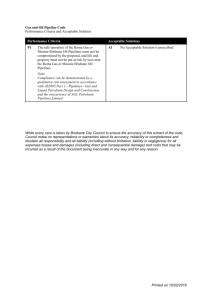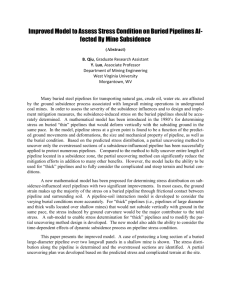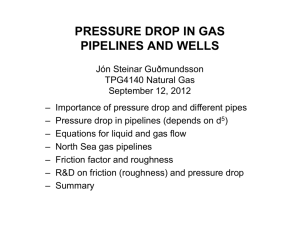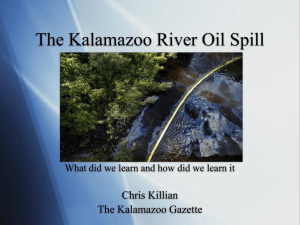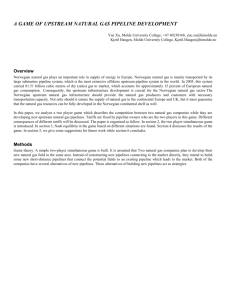pressure drop in gas pipelines
advertisement
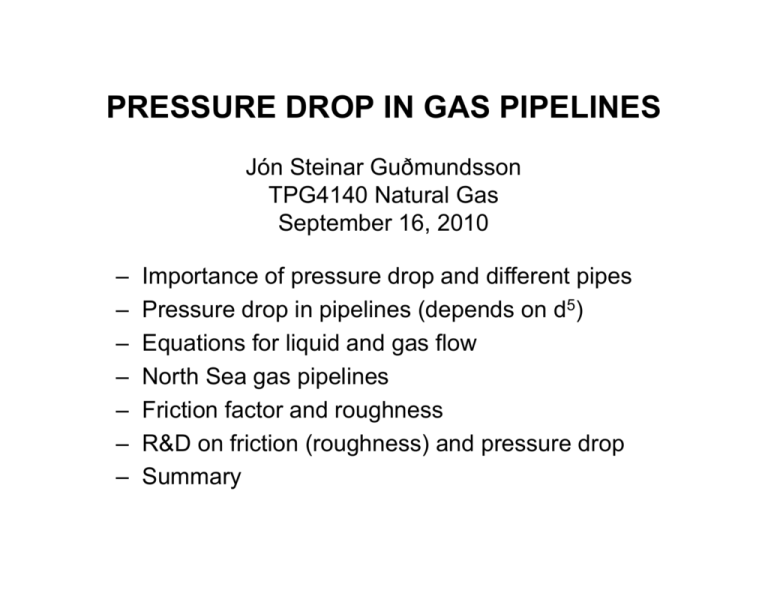
PRESSURE DROP IN GAS PIPELINES Jón Steinar Guðmundsson TPG4140 Natural Gas September 16, 2010 – – – – – – – Importance of pressure drop and different pipes Pressure drop in pipelines (depends on d5) Equations for liquid and gas flow North Sea gas pipelines Friction factor and roughness R&D on friction (roughness) and pressure drop Summary A: Wells, B: Flowlines, C: Risers, D: Process pipes, E: Off-Loading, F: Pipelines Importance of pressure drop • • • • • Transport capacity, we want to be able to push as much gas as possible through existing pipelines to customers. Norwegian export pipelines 100 BCM annually. Expensive gas compression (power and emissions) needed to give sufficient inlet pressure to overcome pressure drop. Gas turbines drive centrifugal compressors offshore (and on land?). Largest consumption of power offshore. Export pipelines have epoxy coating to make wall smoother to reduce wall friction and hence greater production rate. Production capacity (subsea-to-beach), we want to maintain wellhead pressure as low as possible to sustain large production rate from gas fields with time. Eventually we need subsea compression. Large diameter pipelines used to avoid compression platforms along export gas pipelines. On land, compressor stations along pipeline. Pressure and Temperature With Distance Åsgard Transport (69.4 vs. 76.9 MSm³/d) Booster_press Temperature Booster_temp 210 50 200 190 45 40 180 35 170 160 30 25 150 20 140 15 130 120 10 5 110 0 200 400 600 Temperature (°C) Pressure (barg) Pressure 0 800 Distance KP (km) Booster compressor duty: 15.5 MW (most likely roughness) Aamodt (2006) Natural Gas Pipeline Pressure Drop in Pipelines The total pressure drop in pipelines and wells consists of three terms p p g p a p f where g (gravitation), a and f stand for hydrostatic, acceleration and friction, respectively. The three terms can be expressed as p g g sin L pa uu p f f 1 2 u L 2d The angel is measured from horizontal and the lenght is the pipe lenght, not height over/under the surface. The pressure drop due to friction is the Darcy-Weisbach equation. Darcy-Weisbach Equation Darcy-Weisbach Equation Liquid Flow and When Gas Average Density Used pr 2rL 2 r p 2 L 1 2 f u 8 r p 1 2 f u 2 L 8 f L 2 p u 2 d Darcy-Weisbach Equation Force balance, steady-state pipe flow dpr 2 2rdL w r dp w 2 dL w f L 2 p f u 2d 1 fu 2 8 r dp 1 f u 2 2 dL 8 North Sea Pipelines Sletfjerding, E. (1999): Friction Factor in Smooth and Rough Gas Pipelines, Dr.Ing., Petroleum, NTNU. North Sea Pipelines Sletfjerding, E. (1999): Friction Factor in Smooth and Rough Gas Pipelines, Dr.Ing., Petroleum, NTNU. North Sea Pipelines Sletfjerding, E. (1999): Friction Factor in Smooth and Rough Gas Pipelines, Dr.Ing., Petroleum, NTNU. North Sea Pipelines: Pressure Gradient p1 p2 L (p1-p2)/L m bar bar km bar/100 km kg/s A 108,42 85,59 812,4 2,81 205,50 B 166,26 145,59 303,5 6,81 383,50 C 107,97 94,16 619,0 2,23 185,40 D 65,22 63,64 48,5 3,26 185,40 E 129,85 86,8 619,0 6,95 334,10 F 72,03 67,45 48,5 9,44 334,10 G 136,3 112,1 227,0 10,66 167,60 H 146,7 95,5 812,8 6,30 348,40 6,06 Sletfjerding, E. (1999): Friction Factor in Smooth and Rough Gas Pipelines, Dr.Ing., Petroleum, NTNU. Pressure Gradient in Gas Pipelines Gradient (bar/100 km) North Sea, Sletfjerding (1999) Canada, Hughes (1993)* * Mokhatab o.a. (2006, s. 419) 6 (average 8 pipelines) 15-25 Maximum Gas Velocity* Sletfjerdings (1999) North Sea Pipelines A-H, uaverage (m/s), only 10-20 % av NORSOK umaximum *NORSOK P-001 (1999) Pressure Drop Horizontal Gas Pipeline dA M d p 2 2 p p ln L0 2 1 2 fm zRT f p 2 2 2 2 1 Frictional Pressure Drop Gas Pipeline Horizontal Pipeline, Inclined Well f L 2 p f u 2d d A2 M d p 22 2 2 p 2 p1 ln 2 L 0 2 f p1 f m z RT p 22 p12 exp 2ag sin L M a zRT b 1 exp2ag sin L 2 a g sin fm 2 b 2 A2 d Friction Factor in Pipelines Nikuradse’s Sand-Grain Data Moody Chart Add reference to fluid mechanics text book. Blasius’ Equation 0,316 f 0,25 Re Hydrauliskglatterør Re 100.000 Haaland’s Equation 1 1,8 6,9 k log f n Re 3,75d n n 3 for gass n 1 for væske 1,11n Wall Roughness in Pipes Material Average Absolut Roughness (inch) Average Absolut Roughness (µm) Internally plastic coated pipeline Honed bare carbon steel Electropolished bare 13Cr Cement lining Bare carbon steel Fiberglass lining Bare 13Cr 0.200×10-3 0.492×10-3 1.18×10-3 1.30×10-3 1.38×10-3 1.50×10-3 2.10×10-3 5.1 12.5 30.0 33.0 35.1 38.1 53.3 Farshad og Rieke, JPT, oktober 2005, side 82-86. Blasius, Colebrook-White and Haaland 0,316 f 0, 25 Re 2,51 1 k 2 log Re f 3,7 d f 1,11n n 1 1,8 6,9 k log f n Re 3,75d Haaland n=1 for liquids, same as Coolebrook-White Haaland n=3 for gases, same as AGA data Haaland Friction Factor Gases, n=3, Hydraulically smooth and k/d=0.001 0,03500 0,03000 Frictionfaktor 0,02500 0,02000 0,01500 0,01000 0,00500 0,00000 0 200000 400000 600000 800000 1000000 1200000 Reynolds-tall Haaland for gas based on AGA data, lower than for liquids, transition different Haaland Friction Factor Liquid n=1 and gas n=3, k/d=0.001 0,03500 0,03000 Friksjonsfaktor 0,02500 0,02000 0,01500 0,01000 0,00500 0,00000 0 200000 400000 600000 Reynolds-tall Gas 3.8 % lower than liquid at Re=106 800000 1000000 1200000 Nikuradse’s Sand Grain and Real Roughness Sletfjerding Ra = Arithmetic mean roughness Rq = Root-mean-square roughness Rz = Mean peak-to-valley roughness Pipes Used by Sletfjerding Sand-grain roughness ks, Measured roughness Rq , Hurste exponent H 4.5 < (ks/Rq) < 5.8 21 < ks < 181 Summary – Equation for pressure drop in horizontal gas pipelines; the natural logarithm term can often be neglected (gentle decrease in pressure) – Blasius’s equation used for smooth pipes and when Re<105 while Haaland’s equation is general and includes the effect of roughness (recommendet). – Pressure drop in gas pipelines lower than in liquid pipelines. Indicates that correlations are not perfect. – Friction equations conservative, give 5-10 % higher friction factor and hence pressure drop than measured. – Friction correlations have come into focus after EOS (gas density) and gas viscosity correlations have improved. – Pressure drop in gas export pipelines (up to 1 m in diameter and 400-1200 km long) is of great economic importance for Norway as gas exporter.
